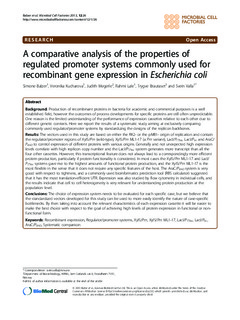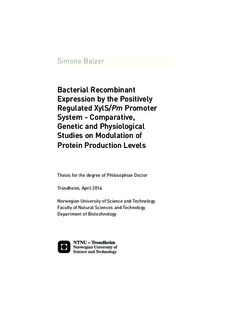| dc.contributor.author | Balzer, Simone | nb_NO |
| dc.date.accessioned | 2014-12-19T13:15:39Z | |
| dc.date.available | 2014-12-19T13:15:39Z | |
| dc.date.created | 2014-06-19 | nb_NO |
| dc.date.issued | 2014 | nb_NO |
| dc.identifier | 727096 | nb_NO |
| dc.identifier.isbn | 978-82-326-0152-3 (printed ver.) | nb_NO |
| dc.identifier.isbn | 978-82-326-0153-0 (electronic ver.) | nb_NO |
| dc.identifier.uri | http://hdl.handle.net/11250/246090 | |
| dc.description.abstract | Økt kontroll over rekombinant proteinproduksjon i bakterier
Rekombinant proteinproduksjon i bakterier beskriver en forskningsaktivitet der man vil produsere nyttige proteiner til for eksempel medisinsk eller industriell bruk ved å innføre DNA fra en fremmed organisme. For at dette skal fungere er det ikke nok å lese av de såkallte rekombinante genene og lage de tilsvarende proteiner. Det må skje på en nøye regulert måte slik at alle delfunksjoner blir kvantitativt tilpasset hverandre. I praksis betyr dette at man bruker forskjellige genetiske kontrollelementer som påvirker transkripsjon eller translasjon.
For å teste effekten av ulike DNA sekvenser på proteinproduksjon brukte jeg blant annet fluorescerende proteiner som enkelt kan detekteres. Regulerbare promotere som først og fremst påvirker transkripsjon er ofte brukt for å kontrollere produksjon av et rekombinant protein. En sentral del av arbeidet mitt var å kartlegge egenskapene til ulike promotersystemer på en veldig systematisk måte.
En annen viktig kontrollregion er DNA region som koder for den 5’-utranslerte regionen (5’-UTR) i mRNA. Den ligger mellom promoter og gen og er spesiell fordi den påvirker både transkripsjon og translasjon. Nyutviklede dataprogrammer prøver å forutsi effekter utifra en 5’-UTR DNA sekvens eller til og med foreslår nye sekvenser med en forventet effekt (f.eks. høy proteinproduksjon). Men det har ikke vært godt samsvar mellom teori og praksis hittil. Jeg jobbet med å finne muligheter for å øke samsvaret mellom biologiske data og bioinformatiske beregninger. Først og fremst kunne jeg vise at det var mulig å få mer kontroll over proteinproduksjon ved å fysisk separere regioner innenfor 5’-UTR som påvirker transkripsjon fra regioner som påvirker translasjon. Så klarte jeg å finne DNA sekvenser som stimulerte de to prosessene hver for seg. Sammenlagt hadde disse en svært positiv, synergistisk effekt.
Mine studier økte forståelsen av de mest grunnleggende mekanismene bak kontroll av rekombinant proteinproduksjon for å styre prosessen på en mer kontrollert måte i fremtiden. | nb_NO |
| dc.description.abstract | Genetically engineered bacteria, especially Escherichia coli, find applications in both university and industry-based research; one important purpose being heterologous production of proteins. Experiences from empiric genetic engineering strategies in pursuit of maximizing or, generally speaking, modulating protein production levels have demonstrated that results are often unpredictable. Even after several decades of research in this field, the complex interplay of the many different genetic and physiological parameters that affect protein production levels are still not fully understood. Among the various expression vectors, mini-RK2 replicons containing the positively regulated xylS/Pm system can be used in E. coli and other Gram-negative bacteria. Using recombinant E. coli strains harboring these vectors as a basis, the influence of different genetic and physiological parameters on recombinant gene expression was systematically compared during this PhD project.
The first parameter studied was how different regulated promoter systems influence expression. Interestingly, a survey of the scientific literature indicated that the performance of commonly used expression systems such as LacI/PT7lac, LacI/Ptrc, and AraC/PBAD, (and also XylS/Pm) had to a very limited extent been properly and systematically compared to each other. Such a comparison was selected as one objective of this PhD project. Given a common vector backbone and expression system insertion points, this comparison made it possible to understand the influence of the systems on production of different selected proteins. This study confirmed that no system was superior to meet all requirements an ideal system should have. However, it was possible to recommend certain systems for different expression purposes. The LacI/PT7lac system, for example, was still best suited for achieving most total production judged by the vast amount of accumulated transcript and total recombinant protein. As for production of soluble (and active) protein, however, use of a variant of XylS/Pm (XylS/Pm ML1-17) or AraC/PBAD were more beneficial for some proteins. The plasmid vector tools developed for this study may be used in future studies to analyze limiting factors for production of in principle any specific protein, including production in an active form.
The second genetic parameter included in the systematic studies was the DNA region corresponding to the 5′-UTR of mRNA. My findings demonstrate that 5′-UTR DNA sequences with strong RBS (like the PT7lac UTR), could enhance protein (here: ß-lactamase) production from XylS/Pm (7-fold) compared to the Pm 5′-UTR. Still, Pm 5′-UTR DNA sequences that were obtained by combinatorial mutagenesis and screening approaches gave rise to even higher protein amounts (up to 20-fold). Also, the relative changes could not be predicted using current sequence analysis tools. Prior to this study, it was already shown that a 5′-UTR DNA region plays a key role in expression due to its involvement in transcription, translation and transcript stability. Therefore, it was hypothesized that one cannot study the effect of 5′-UTR DNA regions on protein production based on parameters influencing translation only (e.g. length of a Shine-Dalgarno sequence). To determine sequence features that influence transcription and to distinguish them from features influencing translation, combinatorial mutagenesis and screening using two efficient vector tools was applied. The new 5′-UTR DNA regions identified with these tools led to primarily stimulated transcript accumulation or protein production indeed, but it was not possible to identify positional hot-spots for mutations that specifically influenced either process. It was however possible to combine a 5′-UTR DNA region carrying mutations that primarily stimulated transcript accumulation with a 5′-UTR DNA region whose mutations primarily stimulated translation The total improvement achieved by this strategy was an impressive 170- fold compared to the native 5′-UTR. It can also be possible to adjust this 5′-UTR DNA region to other promoters and to other coding regions in the future. Hopefully, this strategy will enable more rational design in recombinant protein expression.
Among the remaining parameters that were varied, it was not surprisingly growth temperature, inducer concentration and plasmid (and indirectly gene) copy number that influenced recombinant protein production. This latter parameter also influenced culture heterogeneity at the single-cell level.
The last parameter that this work focused on was the qualitative influence of the expression host on the final product. Certain proteins are prone to be problematic for functional expression in E. coli even independent of the expression levels, the growth conditions or the protein engineering strategies. This was demonstrated by the example of the two difficult-to-express Norwegian Salmonid alphavirus E1 and E2 capsid proteins. Therefore, exploring the use of alternative bacterial hosts was considered; Pseudomonas putida, the organism XylS/Pm originates from, as well as cold-adapted members of the genus Pseudomonas. Vectors developed in this project were suitable to be directly transferred to these hosts; and at least for one protein (mCherry), even higher protein production levels could be achieved in P. putida compared to E. coli. The cold-adapted Pseudomonas strains also showed potential to be used as expression hosts for certain proteins, however, slow growth and low expression levels demonstrated the need to engineer these novel hosts further in the future.
The findings presented in this work not only expand our current understanding of gene expression in general, but also help to approach the goal to optimize bacterial recombinant protein production in a more rational manner than is currently possible. | nb_NO |
| dc.language | eng | nb_NO |
| dc.publisher | Norges teknisk-naturvitenskapelige universitet, Fakultet for naturvitenskap og teknologi, Institutt for bioteknologi | nb_NO |
| dc.relation.ispartofseries | Doktoravhandlinger ved NTNU, 1503-8181; 2014:114 | nb_NO |
| dc.relation.haspart | Balzer, Simone; Kucharova, Veronika; Megerle, Judith; Lale, Rahmi; Brautaset, Trygve; Valla, Svein. A comparative analysis of the properties of regulated promoter systems commonly used for recombinant gene expression in Escherichia coli. Microbial Cell Factories. (ISSN 1475-2859). 12: 26, 2013. <a href='http://dx.doi.org/10.1186/1475-2859-12-26'>10.1186/1475-2859-12-26</a>. | nb_NO |
| dc.relation.haspart | BALZER, S.; LORENTZEN, J.A.; VALLA, S; LALE, R.. Improving bacterial recombinant gene expression by separate optimization and combination of two functional parts of 5’-UTR sequences.. . | nb_NO |
| dc.relation.haspart | Tondervik, Anne; Balzer, Simone; Haugen, Tone; Sletta, Havard; Rode, Marit; Lindmo, Karine; Ellingsen, Trond E.; Brautaset, Trygve. High production of recombinant Norwegian salmonid alphavirus E1 and E2 proteins in Escherichia coli by fusion to secretion signal sequences and removal of hydrophobic domains. BIOTECHNOL BIOPROC E. (ISSN 1226-8372). 18(4): 742-750, 2013. <a href='http://dx.doi.org/10.1007/s12257-013-0085-y'>10.1007/s12257-013-0085-y</a>. | nb_NO |
| dc.title | Bacterial Recombinant Expression by the Positively Regulated XylS/Pm Promoter System - Comparative, Genetic and Physiological Studies on Modulation of Protein Production Levels | nb_NO |
| dc.type | Doctoral thesis | nb_NO |
| dc.contributor.department | Norges teknisk-naturvitenskapelige universitet, Fakultet for naturvitenskap og teknologi, Institutt for bioteknologi | nb_NO |
| dc.description.degree | PhD i bioteknologi | nb_NO |
| dc.description.degree | PhD in Biotechnology | en_GB |


